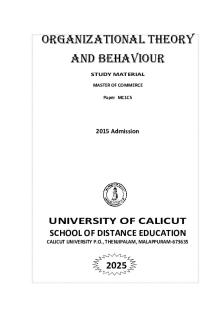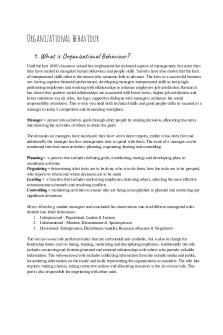(2) Health behaviour theory PDF

| Title | (2) Health behaviour theory |
|---|---|
| Course | Introduction to Psychology |
| Institution | University of Southampton |
| Pages | 2 |
| File Size | 79.1 KB |
| File Type | |
| Total Downloads | 57 |
| Total Views | 251 |
Summary
Health behaviours:
What are they?
What influences them?
Role of beliefs
Theoretical models
Health belief model
Theory of planned behaviour
Social cognitive theory
Critical Evaluation of Health Behaviour Theories
Conceptual issues
Metho...
Description
Health psychology Health behaviour theory Health behaviour
Behaviour that are related to the health status of the individual Kasl and Cobb (1966); “any activity undertaken by a person who believes himself to be healthy for the purpose of preventing disease or detecting disease in an asymptomatic stage”
Types: Kasl and Cobb 1966; -
Health behaviour; prevent disease eg; eat healthy Illness behaviour; seek remedy; eg; going to the doctors Sick role behaviour; get well; take medication
Matarazzo (1984); health behaviours have good and bad impact on health
Behavioural pathogens; behaviours or habits that impair health eg; smoking Behavioural immunogens; behaviours of habits that protect health eg; eating well
Health behaviour is important because lifestyle choice significantly impacts our health. 80% of incidence of coronary heart disease can be attributed to behaviours. Examples include; diabetes prevention program research group (2002); results suggested HB helps enhance an individual’s health status; deigning programs or interventions are useful. Health beliefs are cognitions (thoughts) associated with health. Theoretical models Health behaviour theories
Health belief model (HBM); Rosenstock (1966), Becker (1974); - Susceptibility: vulnerability or risk of developing a health issue - Severity: seriousness of health issue and its physical/social consequences - Barriers: negative aspects of proposed behavior eg; time, effect or cost - Benefits: effectiveness and feasibility of proposed behavior - Cues to action: internal triggers eg; symptoms, external triggers eg; public health campaign Health motivation – motivation to pursue healthy behaviour Self-efficacy – confidence in own ability to perform the behaviour HBM successfully predict a range of behaviour eg; screening, physical activity, diet etc Jones et al (2013); review of 18 HBM-based intervention to promote adherence to ‘health behaviours’ - Nearly 80% showed improvement in HB - But most studies only used certain parts of the model when designing interventions Theory of planned behaviour (TPB); Ajzen and Madden (1986); Ajzen (1991); development from theory of reasoned action. - Attitude: positive/negative beliefs about the outcome of a behaviour and positive/negative evaluations about the behaviour - Subjective norm: perceptions about important other’s attitudes towards the behaviour and motivation to comply with their attitude/behaviour - Perceived behavioural control: perception about internal (skills,ability,information) and external barriers and facilitators to performing a behaviour. Widely used has shown promise in predicting a range of behaviours eg: condon use, organ donation etc Strongest evidence for attitude component Wade et al (2010); opportunistic screening for oral cancer by GPs - Intention predicted by subjective norm and external behavioural control - Behaviour predicted by intention and internal behavioural control
Health psychology Social Cognitive theory (SCT); Bandura et al (2004) - Perceived self-efficacy: central role (belief in own ability) - Outcome expectancies: (cost/benefit) - Health goals: (plans to achieve them) - Socio-cultural factors: beliefs about what others think and do Knowledge as a precondition for change, but not sufficient for changing behaviour Numerous reviews providing evidence for SCT for a variety of behaviours: physical activity, consulting behaviour of practitioners, self-management of chronic conditions etc. Young et al. (2014); reviewed promise of using SCT to predict physical activity behaviour in 44 studies 1/3 of people’s physical activity behaviour could be explained by SCT Strong relationships between physical activity, self-efficacy and goals Inconsistent relationships between outcome expectancies and socio-cultural factors Evaluation of HB theories
Conceptual issues (Ogden, 2019) - Overlap between constructs - Assume casual relationships between different beliefs - Tautological “truth by definition” - Reactivity Methodological issues (Hankins et al, 2000) - Evidence largely cross-sectional - Over-reliance on multiple regression that is applied incorrectly - Sample size and characteristics - Measurement Predictive issues - Imprecision (Sutton, 1998); Prediction to intention not very precise (r2 = .40 - .50) Prediction of behaviour less precise (r2 = .19 - .38) - Other cognitions are needed to predict intention Expanded norms eg; ethical, moral Self-identify and self-affirmation (Harris et al, 2014) Affect (Lawton et al. 2009, 2007) Personality Anticipated regret (O’Carroll et al. 2011) - Intention-behavior gap Intention-behaviour Gap; past behaviour may predict behaviour better than intentions. Implementation intention (Gollwitzer, 1999); specific type of intention AKA ‘if-then’ planning....
Similar Free PDFs

(2) Health behaviour theory
- 2 Pages

Organizational theory and behaviour
- 186 Pages

Consumer behaviour 2
- 21 Pages

Consumer Behaviour Lecture 2
- 8 Pages

Lec+2-+Organisational+Behaviour
- 22 Pages

Chapter 2 ORGANIZATIONAL BEHAVIOUR
- 23 Pages

Experiment 2 behaviour of gases
- 9 Pages

Organizational behaviour
- 67 Pages

Consumer behaviour
- 16 Pages

Health Law Outline 2
- 65 Pages

Health Assessment exam 2
- 6 Pages

Note 2 - Health Law
- 5 Pages
Popular Institutions
- Tinajero National High School - Annex
- Politeknik Caltex Riau
- Yokohama City University
- SGT University
- University of Al-Qadisiyah
- Divine Word College of Vigan
- Techniek College Rotterdam
- Universidade de Santiago
- Universiti Teknologi MARA Cawangan Johor Kampus Pasir Gudang
- Poltekkes Kemenkes Yogyakarta
- Baguio City National High School
- Colegio san marcos
- preparatoria uno
- Centro de Bachillerato Tecnológico Industrial y de Servicios No. 107
- Dalian Maritime University
- Quang Trung Secondary School
- Colegio Tecnológico en Informática
- Corporación Regional de Educación Superior
- Grupo CEDVA
- Dar Al Uloom University
- Centro de Estudios Preuniversitarios de la Universidad Nacional de Ingeniería
- 上智大学
- Aakash International School, Nuna Majara
- San Felipe Neri Catholic School
- Kang Chiao International School - New Taipei City
- Misamis Occidental National High School
- Institución Educativa Escuela Normal Juan Ladrilleros
- Kolehiyo ng Pantukan
- Batanes State College
- Instituto Continental
- Sekolah Menengah Kejuruan Kesehatan Kaltara (Tarakan)
- Colegio de La Inmaculada Concepcion - Cebu



